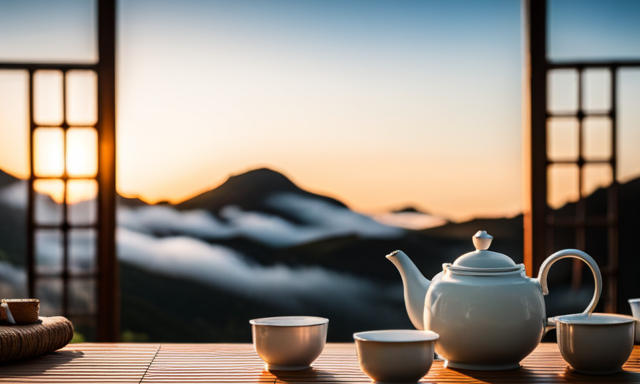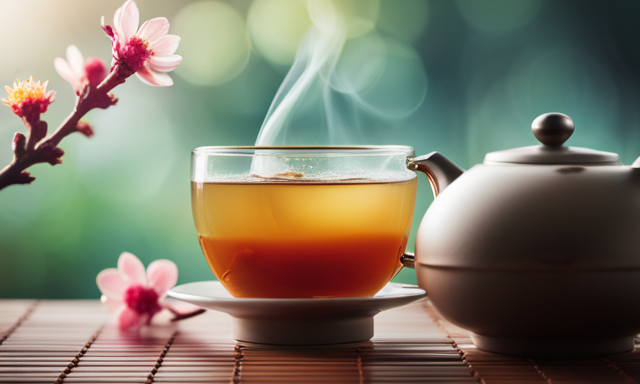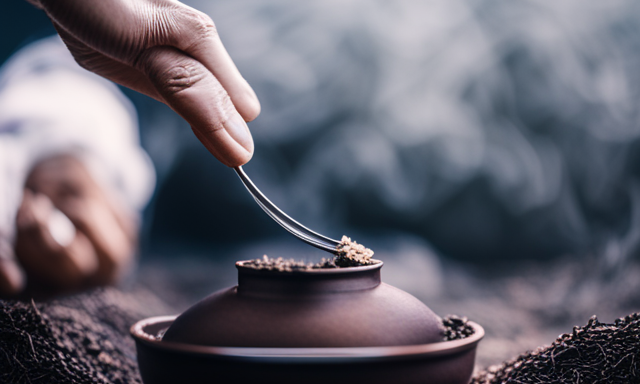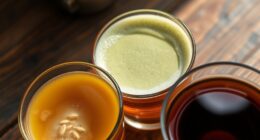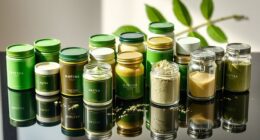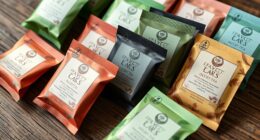As the saying goes, ‘A cup of oolong tea a day keeps the doctor away.’ Well, maybe that’s not exactly how the saying goes, but it’s certainly a sentiment worth considering. Oolong tea, with its unique blend of antioxidants and beneficial compounds, has long been touted for its numerous health benefits.
But how many cups of this delightful brew should one consume in a day to reap its rewards? In this article, we will explore the recommended daily intake of oolong tea, taking into account factors such as weight loss, heart health, mental alertness, and skin health.
We will also discuss the perfect way to brew a cup of oolong tea for maximum enjoyment. So grab your favorite mug, settle in, and let’s dive into the world of oolong tea and discover how much is just right for you.
Key Takeaways
- Fresh, filtered water is important for brewing Oolong Tea to enhance taste and ensure high quality brew.
- Experiment with different steeping times (3-5 minutes) to find the optimal flavor extraction and avoid oversteeping.
- Enjoy Oolong Tea in moderation to benefit from its numerous health benefits without risking potential health risks or disrupting sleep patterns.
- Limit the intake of Oolong Tea, especially close to bedtime, to prevent excessive caffeine consumption and ensure better sleep quality.
Health Benefits of Oolong Tea
Drinking oolong tea daily can work wonders for your health, boosting your immunity and leaving you feeling revitalized and energized.
Oolong tea has been shown to have numerous health benefits, including cancer prevention and blood sugar control. Studies have found that the antioxidants in oolong tea can help reduce the risk of certain types of cancer, such as breast, ovarian, and pancreatic cancer.
Additionally, oolong tea has been shown to help regulate blood sugar levels, making it a great choice for those with diabetes or those looking to manage their blood sugar levels.
With its rich flavor and potential health benefits, incorporating a cup or two of oolong tea into your daily routine can be a simple and enjoyable way to support your overall well-being.
Now let’s discuss the recommended daily intake of oolong tea.
Recommended Daily Intake of Oolong Tea
To achieve the full potential health benefits, aim for a daily intake of oolong tea that aligns with your wellness goals. The recommended dosage varies depending on factors like age, health condition, and caffeine sensitivity. A general guideline is to consume 2-3 cups of oolong tea per day. This amount provides enough antioxidants and polyphenols to support overall health.
Excessive consumption of oolong tea may lead to potential side effects like caffeine-related symptoms (restlessness and difficulty sleeping). So, monitor your caffeine intake from other sources and adjust your oolong tea consumption accordingly.
Considering these factors, finding the right daily consumption of oolong tea will help you reap its benefits without adverse effects. Now, let’s explore the factors to consider when deciding your daily intake.
Factors to Consider When Deciding Daily Consumption
When deciding how much oolong tea to consume daily, there are several factors for you to take into consideration. It’s important to understand that everyone’s body is unique, so what may work for one person may not work for another. Some factors to consider include your overall health, any pre-existing medical conditions, and any medications you may be taking. It’s also important to be aware of the potential health risks associated with consuming too much oolong tea, such as caffeine sensitivity or digestive issues. To help you make an informed decision, here is a table outlining the recommended daily intake of oolong tea based on different factors:
| Factor | Recommended Daily Intake |
|---|---|
| Overall health | 1-2 cups |
| Medical conditions | Consult your doctor |
| Medications | Consult your doctor |
Considering these factors will help you determine the appropriate amount of oolong tea to consume on a daily basis. It’s important to find a balance that works for your individual needs. Now let’s explore how oolong tea can potentially support weight loss.
Oolong Tea and Weight Loss
One potential benefit of oolong tea is its ability to aid in weight loss. This may be of interest to those looking to shed a few pounds. Oolong tea has been shown to have various weight loss benefits, primarily due to its impact on metabolism. Studies suggest that oolong tea can increase metabolism and fat oxidation, which can potentially lead to weight loss.
Additionally, oolong tea contains compounds called catechins that have been found to help reduce body weight and body fat. However, it is important to note that while oolong tea may have some weight loss benefits, it should not be relied upon as a sole method for losing weight. It is always best to combine oolong tea consumption with a healthy diet and regular exercise routine.
Transitioning into the subsequent section about oolong tea and heart health, it is also worth exploring the potential benefits of oolong tea for cardiovascular health.
Oolong Tea and Heart Health
Improve your heart health by incorporating oolong tea into your daily routine.
Oolong tea has been found to have positive effects on cholesterol levels and blood pressure management.
Studies have shown that regular consumption of oolong tea can help reduce LDL (bad) cholesterol levels and increase HDL (good) cholesterol levels, thus lowering the risk of heart disease.
Additionally, oolong tea contains antioxidants that can help relax blood vessels and improve blood flow, which in turn helps regulate blood pressure.
By including oolong tea in your daily diet, you can support your heart health and reduce the risk of cardiovascular issues.
In the next section, we will explore how oolong tea can benefit your digestive health.
Oolong Tea and Digestive Health
Enhance your digestive health with the addition of oolong tea to your daily routine. Oolong tea has been found to have a positive impact on the gut microbiome, promoting a healthy balance of bacteria in the digestive system. Studies have shown that oolong tea can help improve digestion by increasing the production of digestive enzymes and reducing inflammation in the gut. It has also been found to alleviate symptoms of gastrointestinal disorders such as bloating and constipation.
To give you a better understanding, here is a table that highlights the benefits of oolong tea for digestive health:
| Benefit | Description |
|---|---|
| Promotes gut health | Oolong tea supports a healthy balance of gut bacteria, which is essential for proper digestion. |
| Enhances digestion | Oolong tea increases the production of digestive enzymes, aiding in the breakdown of food. |
| Reduces inflammation | The anti-inflammatory properties of oolong tea can help alleviate inflammation in the gut. |
Incorporating oolong tea into your daily routine can be a practical way to improve your digestive health. Now, let’s move on to the next section about oolong tea and mental alertness.
Oolong Tea and Mental Alertness
To boost mental alertness, incorporating oolong tea into your daily routine can be practical and effective. Oolong tea has been found to enhance mental clarity and cognitive function. Here are four reasons why oolong tea can help improve mental alertness:
- Oolong tea contains caffeine, which stimulates the central nervous system and increases alertness.
- It contains theanine, an amino acid that promotes relaxation and improves attention span.
- Oolong tea has been shown to enhance memory and learning abilities.
- The antioxidants present in oolong tea protect the brain from oxidative stress, promoting better cognitive function.
By incorporating oolong tea into your daily routine, you can experience improved mental alertness and cognitive performance.
Transitioning into the next section about oolong tea and skin health, let’s explore how this tea can benefit your skin.
Oolong Tea and Skin Health
Incorporating oolong tea into your daily routine can do wonders for your skin health. Oolong tea contains powerful antioxidants that can help fight acne and promote anti-aging effects.
The polyphenols in oolong tea have been shown to reduce sebum production, which can help prevent clogged pores and reduce the risk of acne breakouts.
Additionally, the antioxidants in oolong tea can help protect the skin from free radicals and promote collagen production, leading to firmer and more youthful-looking skin.
To reap the benefits, simply enjoy a few cups of oolong tea throughout the day.
Now, let’s move on to how to brew the perfect cup of oolong tea.
How to Brew the Perfect Cup of Oolong Tea
When it comes to brewing the perfect cup of Oolong Tea, there are a few key steps to follow. Firstly, use fresh, filtered water to enhance the taste. Secondly, steep the tea leaves for 3-5 minutes to extract the perfect balance of flavors. Don’t forget to experiment with different steeping times to find your preferred strength.
Now, let’s move on to the next section where we will discuss the importance of enjoying Oolong Tea in moderation.
Conclusion: Enjoying Oolong Tea in Moderation
In the grand tapestry of tea enjoyment, it is crucial to savor the delicate nuances of Oolong Tea without overindulging. While Oolong Tea offers numerous health benefits, it’s important to enjoy it in moderation to avoid any potential health risks.
One such concern is its impact on sleep quality. Oolong Tea contains caffeine, albeit in smaller amounts compared to other teas. Consuming excessive amounts of Oolong Tea, especially close to bedtime, may disrupt your sleep patterns and lead to difficulties falling asleep or staying asleep throughout the night.
It is recommended to limit your intake of Oolong Tea to a moderate amount, preferably earlier in the day. By doing so, you can enjoy the many benefits of Oolong Tea while maintaining a healthy sleep routine.
Frequently Asked Questions
Can oolong tea be consumed by pregnant women?
During pregnancy, it is generally recommended to limit or avoid oolong tea consumption due to its caffeine content. While oolong tea has potential health benefits, it’s important to prioritize the well-being of the developing fetus.
Does oolong tea contain caffeine?
Oolong tea contains caffeine, which can have various effects on the body. The caffeine content in oolong tea can vary, but on average, it contains about 37 mg per 8-ounce cup. It’s important to consider the effects of caffeine when consuming oolong tea.
Can oolong tea help in reducing cholesterol levels?
Oolong tea can potentially help in reducing cholesterol levels. Studies suggest its effectiveness in weight loss and its impact on blood sugar levels. Incorporating oolong tea as part of a balanced diet may provide practical benefits for managing cholesterol levels.
Does oolong tea have any negative side effects?
Oolong tea has numerous benefits, including aiding in weight loss. However, it’s important to be aware of potential risks. While generally safe, excessive consumption may lead to caffeine-related side effects.
Is it necessary to drink oolong tea at a specific time of the day for maximum benefits?
For optimal benefits, it is not necessary to drink oolong tea at a specific time of the day. However, studies suggest that consuming it before meals may aid in weight loss due to its metabolism-boosting properties.
Conclusion
After exploring the health benefits of oolong tea, understanding the recommended daily intake, and considering various factors, it is clear that enjoying oolong tea in moderation can have significant positive effects on overall well-being.
From aiding in weight loss to promoting heart health, mental alertness, and even improving skin health, oolong tea is a versatile and beneficial beverage.
By brewing the perfect cup of oolong tea, you can unlock its full potential. So go ahead, indulge in this delicious and health-boosting tea, but remember, moderation is key for optimal results.
Cheers to a healthier lifestyle!

